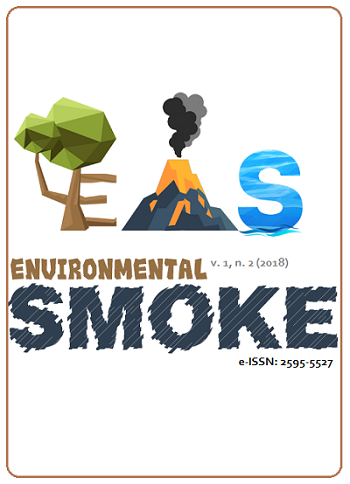ANALYSIS OF THE “POKÉMON GO” ENVIRONMENT CONSIDERING THE PERVASIVE INFORMATION ARCHITECTURE
Views: 823DOI:
https://doi.org/10.32435/envsmoke.20181215-29Keywords:
Pervasive computing, Heuristics, Human-Computer Interaction.Abstract
In Information Science research related to the use of information has been developed, with influence of information technology and telecommunications. Its development was more accelerated in the post-industrial period when society began to produce a large amount of information. In the 21st century, access to information through the use of the Internet with smartphones has become something within reach of the population, providing an increase in communication. The objective of this work was to analyze the “Pokémon GO” application, considering the Architecture of Pervasive Information in which, the motivation of the use of this subject was the recent launch of applications for smartphones that use pervasive environments, highlighting the game that became a huge success of downloads and brought a great innovation in the way of play. For the accomplishment of this research, the participant research methodology was adopted, in which the user-researcher interacts directly with the searched object. The collected data were analyzed in a qualitative way. Using the game environment and evaluating the pervasive interaction presented at the threshold between the physical and digital environment, the heuristics described by Resmini and Rosati were considered. In the use of the game were explored the physical environments present in the city of João Pessoa, in addition to the moments of interaction. In the results, the adherence to the proposed heuristics was discussed and these were punctuated as Present, Partially Present and Not Present. Finally, the data were analyzed suggesting improvements both for the game, considering the Pervasive Information Architecture, and for the environment itself.
Downloads
References
ARAÚJO, C. Correntes teóricas da ciência da informação. Ciência da informação, v. 38, n. 3, p. 192-204, 2009. Available at: http://www.scielo.br/scielo.php?pid=S0100-19652009000300013&script=sci_abstract&tlng=pt. Accessed on: 15 May 2018.
BARRETO, A.A. A condição da informação. São Paulo em Perspectiva, São Paulo, v. 16, n. 3, p. 67-74, 2002. Available at: http://www.scielo.br/scielo.php?script=sci_ arttext&pid=S0102-88392002000300010. Accessed on: 16 May 2018.
BORKO, H. Information science: What is it? American Documentation, v. 19, n. 1, 1968.
BUSH, V. As we may may think. Atlantic monthly, v. 176, n. 1, p. 112-124, 1945. Available at: http://worrydream.com/refs/Bush%20-%20As%20We%20May%20 Think%20(Life%20Magazine%209-10-1945).pdf. Accessed on: 11 May 2018.
CAPURRO, R. Epistemologia e ciência da informação. 2003. Available at: http:// www.capurro.de/enancib_p.htm. Accessed on: 16 May 2018.
CASTELLS, M. A sociedade em rede. 8. ed. São Paulo: Paz e Terra, 1999.
FREIRE, G.H. Ciência da informação: temática, histórias e fundamentos. Perspectivas em Ciência da informação, Belo Horizonte, v. 11, n. 1, p. 6-19. 2006. Available at: http://www.scielo.br/pdf/pci/v11n1/v11n1a02. Accessed on: 16 May 2018.
LIMA, F. O. A sociedade digital: o impacto da tecnologia na sociedade, na cultura, na educação e nas organizações. Rio de Janeiro: Qualitymark, 2000. 172 p.
MUNDANEUM. The origins of the Internet in Europe: collecting, indexing & sharing knowledge. Exposição digital. [Projeto Google Arts & Culture]. 2013. Available at:
https://www.google.com/culturalinstitute/beta/exhibit/QQ-RRh0A?hl=pt-BR. Accessed on: 16 May 2018.
OTLET, P. Traité de documentation: le livre sur le livre, théorie et pratique. Bruxelas: Mundaneum, 1934. 480 p.
PADUA, M.C. Arquitetura da informação pervasiva e experiência do usuário: avaliando os ambientes informacionais do Proine. 2014. 239 f. Dissertação (Mestrado em Ciência da Informação) - Universidade Federal da Paraíba, João Pessoa, 2014.
REES, A.; SARACEVIC, T. Education for Information Science and its relation to librarianship. opus cit. p. 98, 1967.
RESMINI, A.; ROSATI, L. Pervasive information architecture: designing cross-channel user experiences. Burlington: Morgan Kaufmann, 2011a. 272p.
ROSENFELD, L.; MORVILLE, P.; ARANGO, J. Information architecture: for the web and beyond. Sebastopol: O'Reilly Media, 2015. 486 p.
SCHLEDER, V; SILVA, D. O uso da internet como uma ferramenta de marketing de relacionamento nas agências de comunicação de Santa Maria-RS. Iniciacom, v. 2, n. 2, 2010. Available at: http://portcom.intercom.org.br/revistas/index.php/iniciacom/ article/view/691/627. Accessed on: 15 May 2018.
SEVERINO, A.J. Metodologia do trabalho científico. São Paulo: Cortez, 2007. 304 p.
WURMAN, R.S. Information architects. 2. ed. Lakewood: Watson-Guptill Pubns, 1997. 235p.
Downloads
Published
How to Cite
Issue
Section
License
The copyright for manuscripts published in Environmental Smoke belongs to the author, with first publication rights for the journal. The published articles are of total and exclusive responsibility of the authors.
































































